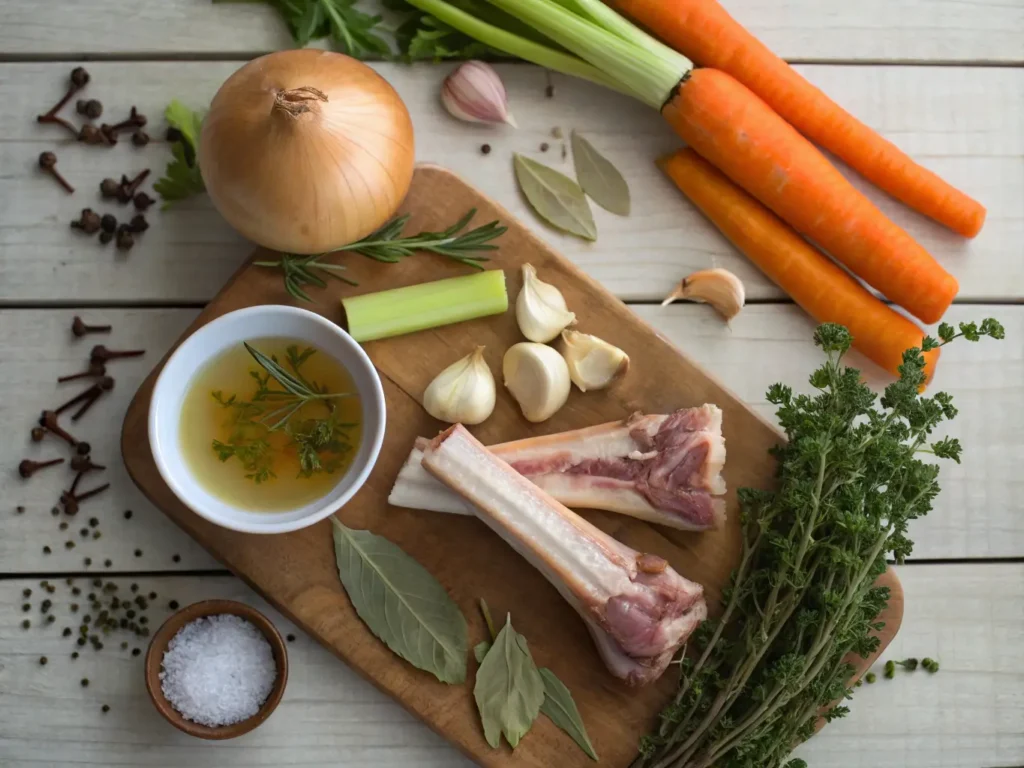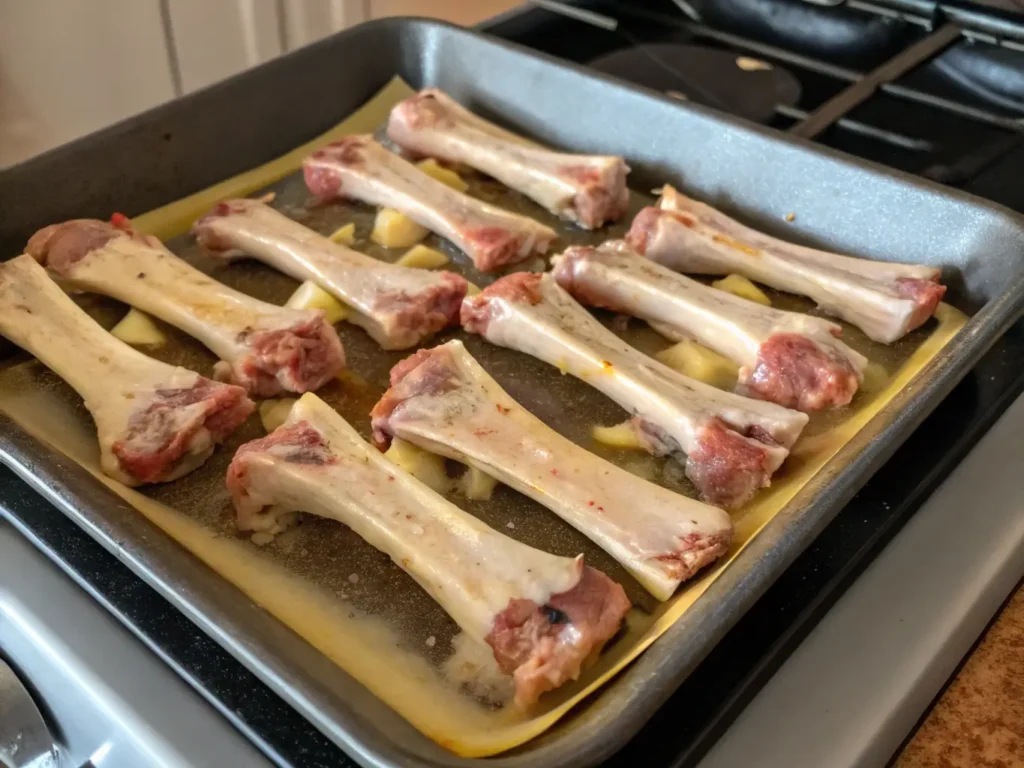If you’ve ever sipped a deeply savory, comforting bowl of soup or broth and thought, “How does it taste this good?” chances are, the secret was soup bones. These humble, often overlooked ingredients are what give your soup or stock depth, body, and richness you just can’t get from bouillon cubes or boxed broth.
Whether you’re building a hearty beef stew, a light chicken noodle soup, or nourishing bone broth, starting with the right soup bones makes all the difference. They provide natural collagen, essential minerals, and an unmatched flavor foundation.
In this guide, we’ll walk you through:
- What soup bones are
- How to choose the best ones
- Which ingredients to pair them with
- And how Chef Lucas Benette gets maximum flavor with minimal effort
Let’s begin by understanding the basics.

What Are Soup Bones?
Soup bones are bones usually from beef, pork, chicken, or fish used as the base for making broth, stock, or soup. They often include marrow, cartilage, connective tissue, and small bits of meat, all of which break down during cooking to create a rich, flavorful liquid.
Types of Common Soup Bones:
- Beef marrow bones from femur or knuckle, rich in gelatin
- Chicken carcasses full of flavor and collagen
- Pork neck or shoulder bones often used in ramen and hearty soups
- Fish heads or frames great for quick, delicate fish stock
These bones are typically simmered for hours, allowing their nutrients and flavors to infuse into the cooking liquid, producing restaurant quality broth right from your own kitchen.
Ingredients for Bone Broth or Soup Stock
Making broth with soup bones is incredibly simple, but the magic comes from using fresh, quality ingredients and allowing enough time for everything to develop deep flavor.
Here’s what you’ll need to get started:
Base Ingredients:
- 2–3 lbs of soup bones (beef, chicken, pork, or a mix)
- 10 cups cold water
- 1 tbsp apple cider vinegar or white vinegar (helps extract nutrients)
Aromatics & Vegetables:
- 2 carrots, chopped
- 2 celery stalks, chopped
- 1 onion, halved (no need to peel)
- 4 cloves garlic, smashed
- 1 bay leaf
- 1 tsp peppercorns
- Optional: a handful of parsley stems, thyme, or leek greens
You don’t need to peel or finely chop the vegetables this is a rustic, slow simmered process, and everything will be strained out later.

Chef Lucas Benette’s Roasting and Simmering Technique
If you want a broth that’s dark, flavorful, and full bodied, Chef Lucas Benette swears by roasting your soup bones before simmering.
Here’s his step by step method:
1. Roast the Bones First
- Preheat your oven to 425°F (220°C)
- Spread the bones on a baking sheet in a single layer
- Roast for 25–35 minutes, turning once, until well browned
“Roasting caramelizes the marrow and meat, giving your broth a rich, golden color and savory flavor,” says Lucas.
2. Simmer Low and Slow
- Transfer the bones to a large stockpot
- Add cold water to cover, plus your vegetables and vinegar
- Bring to a gentle simmer, not a boil
- Skim off foam during the first hour
- Simmer uncovered for:
- Beef or pork bones: 12–24 hours
- Chicken bones: 6–8 hours
- Fish bones: 30–45 minutes
3. Strain and Store
- Strain the broth through a fine mesh sieve
- Discard solids and cool the broth completely
- Store in glass jars or freezer containers
- Optional: Let it chill and skim the fat from the top before using

How to Make Broth or Soup Using Soup Bones (Step by Step)
Using soup bones to make your own broth is one of the most satisfying kitchen skills you can master. It’s simple, budget friendly, and gives you a base that’s richer and healthier than anything from a box or can.
Here’s how to do it, start to finish:
Step 1: Roast Your Bones (Optional, But Recommended)
- Preheat oven to 425°F (220°C)
- Arrange bones on a baking sheet and roast for 25–35 minutes
- Turn once for even browning
- This step adds deep color and richer flavor to your broth
Step 2: Combine Everything in a Pot
- Add roasted bones to a large stockpot or slow cooker
- Pour in 10 cups of cold water, just enough to cover
- Add vinegar, vegetables, and seasonings
- Let it sit for 20–30 minutes to start pulling minerals from the bones
Step 3: Simmer Low and Slow
- Bring to a gentle simmer (don’t let it boil hard)
- Skim any foam or scum from the top during the first hour
- Keep at a low simmer, uncovered or loosely covered
- Add water as needed to keep bones submerged
Step 4: Strain, Cool, and Store
- Use a fine mesh strainer to remove bones and solids
- Let the broth cool slightly
- Pour into jars or containers
- Store in the fridge (up to 5 days) or freeze (up to 3 months)
Tip: After chilling, a gelatinous texture on top means you did it right it’s packed with collagen!

Bone Type & Simmer Time Chart
Here’s a handy reference for how long to cook each type of soup bone and what flavor to expect:
| Bone Type | Best For | Simmer Time | Flavor Profile |
|---|---|---|---|
| Beef Marrow | Rich bone broth | 12–24 hours | Deep, meaty, full bodied |
| Chicken Carcass | Light soup stock | 6–8 hours | Savory and slightly sweet |
| Pork Neck Bones | Ramen or stew base | 8–12 hours | Rich, slightly fatty |
| Fish Heads/Frames | Clear fish stock | 30–45 minutes | Clean, delicate, oceanic |
FAQs About Soup Bones
1. What bones are best for soup?
The best bones for soup depend on the flavor and texture you’re aiming for. Commonly used options include:
- Beef marrow bones (femur or knuckle) for rich, gelatinous broth
- Chicken backs, necks, or carcasses for light, savory stock
- Pork neck bones for a slightly fatty and flavorful broth
- Fish heads or frames for a clean, quick cooking seafood stock
A mix of meaty and joint bones is ideal for both flavor and collagen.
2. What are soup bones called?
Soup bones may be labeled as:
- Stock bones
- Marrow bones
- Neck bones
- Knuckle bones
- Carcasses (especially for poultry)
Butchers and grocery stores often group them as “soup bones” in the freezer or meat section. You might also see them sold as bone broth bones.
3. What is the purpose of soup bones?
Soup bones are used to make broth or stock, the flavorful liquid base for soups, sauces, stews, and gravies. As bones simmer, they release collagen, gelatin, minerals, and flavor into the water, creating a nourishing and deeply savory result. They’re essential for making homemade soups taste full bodied and satisfying.
4. Can you get soup bones from a butcher?
Yes, definitely! Local butchers are one of the best sources for fresh, high quality soup bones. You can request specific types like beef knuckle, pork neck, or chicken backs and even ask for bones with extra meat or marrow. Many butchers will cut them to size or provide a mixed selection for broth making.
Final Thoughts on Getting the Most from Soup Bones
Making broth with soup bones isn’t just a culinary tradition it’s a smart, sustainable, and rewarding way to cook. With just bones, water, and a few humble vegetables, you create something deeply nourishing, flavorful, and versatile.
Whether you’re simmering beef marrow for pho, pork bones for ramen, or chicken carcasses for classic stock, the method is simple and the result is liquid gold.
Thanks to Chef Lucas Benette’s roasting technique and layering tips, you can now make restaurant quality broth in your own kitchen. Store it, sip it, freeze it, or turn it into a soup that warms you from the inside out.




